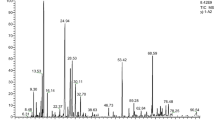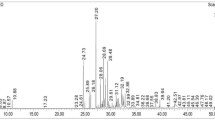Abstract
Essential oils are potential antimicrobial agents and can be used as active ingredients in the pharmaceutical, food and cosmetics industries. This work intends to evaluate the antibacterial activity and design a strategy for the proposition of the mechanism of action of Melaleuca leucadendra essential oil. Optimum concentration of the bacteria and the phase where they had the highest pathogenic activity were determined. Results show that for each microorganism it is necessary to use a different concentration at the time of adjusting the initial inoculum, and that the time to achieve exponential growth phase varies from one to the other. M. leucadendra essential oil demonstrated in vitro antimicrobial properties. This oil was chemically characterized and the main compounds were evaluated by their mechanism of antibacterial action based on structure–activity analysis. The mechanism is related to the increase of bacteria cell membrane permeability. This indication was confirmed by flow cytometry and transmission electronic microscopy. Thus, in silico analysis is an important tool in the search for new antimicrobial agents and these results showed that M. leucadendra essential oil may be useful on the development of new chemotherapies or food preservation systems.




Similar content being viewed by others
References
Liu Y, Ding S, Shen J, Zhu K (2019) Nonribosomal antibacterial peptides that target multidrug- resistant bacteria. Nat Prod Rep 36:573–592. https://doi.org/10.1039/C8NP00031J
Kupferschmidt K (2016) Resistance fighters. Science 352(6287):758–761. https://doi.org/10.1126/science.352.6287.758
Loureiro RJ, Roque F, Rodrigues AT, Herdeiro MT, Ramalheira E (2016) Use of antibiotics and bacterial resistances: Brief notes on its evolution. Rev Port Saúde Pública 34(1):77–84. https://doi.org/10.1016/j.rpsp.2015.11.003
World Health Organization (WHO) (2018) Antimicrobial Resistance Report. Available at https://reports.weforum.org/global-risks-2018/anti-microbial-resistance/. Accessed December 1, 2018.
Kappor G, Saigal S, Elongavan A (2017) Action and resistance mechanisms of antibiotics: A guide for clinicians. J Anaesthesiol Clin Pharmacol 33(3):300–305. https://doi.org/10.4103/joacp.JOACP_349_15
Gajdács M (2019) The concept of an ideal antibiotic: Implications for drug design. Molecules 24(5):892. https://doi.org/10.3390/molecules24050892
Kalemba D, Kunicka A (2003) Antibacterial and antifungal properties of essential oils. Curr Med Chem 10(10):813–829. https://doi.org/10.2174/0929867033457719
Ríos JL, Recio MC (2005) Medicinal plants and antimicrobial activity. J Ethnopharmacol 100(1–2):80–84. https://doi.org/10.1016/j.jep.2005.04.025
Savoia D (2012) Plant-derived antimicrobial compounds: alternatives to antibiotics. Future Microbiol 7(8):979–990. https://doi.org/10.2217/fmb.12.68
Tiwari BK, Valdramidis VP, O’Donnell CP, Muthukumarappan K, Bourke P, Cullen PJ (2009) Application of natural antimicrobials for food preservation. J Agric Food Chem 57(14):5987–6000. https://doi.org/10.1021/jf900668n
Sharifi-Rad J, Salehi B, Varoni EM, Sharopov F, Yousaf Z, Ayatollahi SA, Kobarfard F, Sharifi-Rad M, Afdjei MH, Sharifi-Rad M, Iriti M (2017) Plants of the Melaleuca genus as antimicrobial agents: From farm to pharmacy. Phytother Res 31(10):1475–1494. https://doi.org/10.1002/ptr.5880
Carson FC, Hammer KA, Riley TV (2006) Melaleuca alternifolia (Tea Tree) oil: a review of antimicrobial and other medicinal properties. Clin Microbiol Rev 19(1):50–62. https://doi.org/10.1128/CMR.19.1.50-62.2006
Padalia RC, Verma RS, Chauhan A, Chanotiya CS (2015) The essential oil composition of Melaleuca leucadendra L. grown in India: A novel source of (E)-nerolidol. Ind Crop Prod 69:224–227. https://doi.org/10.1016/j.indcrop.2015.02.019
Amenta R, Camarda L, Di Stefano V, Lentini F, Venza F (2000) Traditional medicine as a source of new therapeutic agents against psoriasis. Fitoterapia 71(1):S13–S20. https://doi.org/10.1016/s0367-326x(00)00172-6
Valdés AFC, Martínez JM, Lizama RS, Vermeersch M, Cos P, Maes L (2008) In vitro anti-microbial activity of the Cuban medicinal plants Simarouba glauca DC, Melaleuca leucadendron L and Artemisia absinthium L. Mem Inst Oswaldo Cruz 103(6):615–618. https://doi.org/10.1590/s0074-02762008000600019
Sarr FB, Sarr M, Diop D, Mo K, Bâ A, Guèue L, Diallo AS, Samb A, Andriantsitohaina R, Cissé F (2010) In vitro modulation of tracheal smooth muscle reactivity by extracts of some Senegalese medicinal plants. J Med Plant Res 4(1):13–18
Hiermann A, Bucar F (1994) Influence of some traditional medicinal plants of Senegal on prostaglandin biosynthesis. J Ethnopharmacol 42(2):111–116. https://doi.org/10.1016/0378-8741(94)90104-x
Niang S, Tine Y, Diatta B, Diallo M, Fall M, Seck NB, Kane A (2015) Negative cutaneous effects of medicinal plants in Senegal. Br J Dermatol 173(2):26–29. https://doi.org/10.1111/bjd.13679
Seibert JB, Rodrigues IV, Carneiro SP, Amparo TR, Lanza JS, Frezard FJG, Souza GHB, Santos ODH (2019) Seasonality study of essential oil from leaves of Cymbopogon densiflorus and nanoemulsion development with antioxidant activity. Flavour Frag J 34(1):5–14. https://doi.org/10.1002/ffj.3472
Seibert JB, Bautista-Silva JP, Amparo TR, Peti A, Pervier P, Almeida JCS, Azevedo MC, Silveira BM, Brandão GC, Souza GHB, Teixeira LFM, Santos ODH (2019) Development of propolis nanoemulsion with antioxidant and antimicrobial activity for use as a potential natural preservative. Food Chem 287:61–67. https://doi.org/10.1016/j.foodchem.2019.02.078
Ostrosky EA, Mizumoto MK, Lima MEL, Kaneko TM, Nishikawa SO, Freitas BR (2008) Methods for evaluation of the antimicrobial activity and determination of minimum inhibitory concentration (MIC) of plant extracts. Rev Bras Farmacogn 18(2):301–307. https://doi.org/10.1590/S0102-695X2008000200026
Oliveira MLG, Assenco RAG, Silva GDF, Lopes JC, Silva FC, Lanna MCS, Magalhães JC, Duarte LP, Viera-Filho SA (2014) Cytotoxicity, anti-poliovirus activity and in silico biological evaluation of constituents from Maytenus gonoclada (Celastraceae). Int J Pharm Pharm Sci 6(10):130–137
Seibert JB, Viegas JSR, Almeida TC, Amparo TR, Rodrigues IV, Lanza JS, Frézard FJG, Soares RDOA, Teixeira LFM, De Souza GHBS, Vieira PMA, Barichello JM, Dos Santos ODH (2019) Nanostrucutured systems improve the antimicrobial potential of the essential oil from Cymbopogon densiflorus leaves. J Nat Prod 82(12):3208–3220. https://doi.org/10.1021/acs.jnatprod.8b00870
Cui H, Zhang C, Li C, Lin L (2019) Antibacterial mechanism of oregano essential oil. Ind Crop Prod 139:111498. https://doi.org/10.1016/j.indcrop.2019.111498
Crisler JD, Newville TM, Chen F, Clark BC, Schneegurt MA (2012) Bacterial growth at the high concentrations of magnesium sulfate found in martian soils. Astrobiology 12(2):98–106. https://doi.org/10.1089/ast.2011.0720
Ernebjerg M, Kishony R (2012) Distinct growth of soil bacteria as revealed by larger scale colony tracking. Appl Environ Microbiol 78(5):1345–1352. https://doi.org/10.1128/AEM.06585-11
Lohakachornpan P, Rangsipanuratn W (2001) Chemical compositions and antimicrobial activities of essential oil from Melaleuca leucadendron var minor. Thai J Pharm Sci 25(3–4):133–139
Silva CJ, Barbosa LC, Maltha CR, Pinheiro AL, Ismail FM (2007) Comparative study of the essential oils of seven Melaleuca (Myrtaceae) species grown in Brazil. Flavour Frag J 22(6):474–478. https://doi.org/10.1002/ffj.1823
Brophy JJ, Lassak EV (1988) Melaleuca leucadendra L leaf oil: two phenylpropanoid chemotypes. Flavour Fragr J 3(1):43–46. https://doi.org/10.1002/ffj.2730030109
Aboutabl EA, Tohamy SFEL, De Pooter HL, De Buyck LF (1991) A comparative study of the essential oils from three Melaleuca species growing in Egypt. Flavour Fragr J 6(2):139–141. https://doi.org/10.1002/ffj.2730060209
Farag RS, Shalaby AS, El-Baroty GA, Ibrahim NA, Ali MA, Hassan EM (2004) Chemical and biological evaluation of the essential oils of different Melaleuca species. Phytother Res 18(1):30–35. https://doi.org/10.1002/ptr.1348
Pino J, Bello A, Urquiola A, Agüero J, Marbot R (2002) Chemical composition of Cajuput oil (Melaleuca leucadendra L.) from Cuba. J Essent Oil Res 14:10–11. https://doi.org/10.1080/10412905.2002.9699744
Silva CJ, Barbosa LCA, Demuner AJ, Montanari RM, Pinheiro AL, Dias I, Andrade NJ (2010) Chemical composition and antibacterial activities from the essential oils of Myrtaceae species planted in Brazil. Quim Nova 33(1):104–108. https://doi.org/10.1590/S0100-40422010000100019
Padalia RC, Verma RS, Chauhan A, Goswami P, Verma SK, Darokar MP (2015) Chemical composition of Melaleuca linarrifolia Sm. from India: a potential source of 1,8-cineole. Ind Crop Prod 63:264–268. https://doi.org/10.1016/j.indcrop.2014.09.039
Carson SF, Mee BJ, Riley TV (2002) Mechanism of action of Melaleuca alternifolia (Tea Tree) oil on Staphylococcus aureus determined by time-kill, lysis, leakage, and salt tolerance assays and electron microscopy. Antimicrob Agents Chemother 46(6):1914–1920. https://doi.org/10.1128/aac.46.6.1914-1920.2002
Cox SD, Mann CM, Markham JL, Bell HC, Gustafson JE, Warmington JR, Wyllie SG (2000) The mode of antimicrobial action of the essential oil of Melaleuca alternifolia (tea tree oil). J Appl Microbiol 88(1):170–175. https://doi.org/10.1046/j.1365-2672.2000.00943.x
Li WR, Li HL, Shi QS, Sun TL, Xie XB, Song B, Huang XM (2016) The dynamics and mechanism of the antimicrobial activity of tea tree oil against bacteria and fungi. Appl Microbiol Biotechnol 100(20):8865–8875. https://doi.org/10.1007/s00253-016-7692-4
Longbottom CJ, Carson CF, Hammer KA, Mee BJ, Riley TV (2004) Tolerance of Pseudomonas aeruginosa to Melaleuca alternifolia (tea tree) oil is associated with the outer membrane and energy-dependent cellular processes. J Antimicrob Chemother 54(2):386–392. https://doi.org/10.1093/jac/dkh359
Mann CM, Cox SD, Markham JL (2000) The outer membrane of Pseudomonas aeruginosa NCTC 6749 contributes to its tolerance to the essential oil of Melaleuca alternifolia (tea tree oil). Lett Appl Microbiol 30(4):294–297. https://doi.org/10.1046/j.1472-765x.2000.00712.x
Trombetta D, Castelli F, Sarpietro MG, Venuti V, Cristiani M, Daniele C, Saija A, Mazzanti G, Bisignano G (2005) Mechanism of antibacterial actions of three monoterpenes. Antimicrob Agents Chemother 49(6):2474–2478. https://doi.org/10.1128/AAC.49.6.2474-2478.2005
Ultee A, Bennik MHJ, Moezelard R (2002) The phenolic hydroxyl group of carvacol is essential for action against food-borne pathogen Bacillus cereus. Appl Environ Microbiol 68(4):1561–1568. https://doi.org/10.1128/AEM.68.4.1561-1568.2002
Ben AA, Combes S, Preziosi-Belloy L, Gontard N, Chalier P (2006) Antimicrobial activity of carvacrol related to its chemical structure. Lett Appl Microbiol 43(2):149–154. https://doi.org/10.1111/j.1472-765X.2006.01938.x
Lambert RJ, Skandamis PN, Coote PJ, Nychas GJ (2001) A study of the minimum inhibitory concentration and mode of action of oregano essential oil, thymol and carvacrol. J Appl Microbiol 91(3):453–462. https://doi.org/10.1046/j.1365-2672.2001.01428.x
Nazzaro F, Fratianni F, De Martino L, Coppola R, De Feo V (2013) Effect of Essential Oils on Pathogenic Bacteria. Pharmaceuticals 6:1451–1474. https://doi.org/10.3390/ph6121451
Acknowledgments
The authors would like to acknowledge the Center of Microscopy at the Federal University of Minas Gerais for providing equipment and technical support for experiments involving electron microscopy. This study was financed in part by the Coordenação de Aperfeiçoamento de Pessoal de Nível Superior—Brazil (CAPES)—Finance Code 001.
Author information
Authors and Affiliations
Contributions
JPBS and JBS conducted experiments and wrote the manuscript. TRA and IVR contributed with analytical tools and analyzed data. LFMT, GHBS and ODHS designed research, wrote and revised the manuscript. All authors read and approved the manuscript.
Corresponding author
Additional information
Publisher's Note
Springer Nature remains neutral with regard to jurisdictional claims in published maps and institutional affiliations.
Rights and permissions
About this article
Cite this article
Bautista-Silva, J.P., Seibert, J.B., Amparo, T.R. et al. Melaleuca leucadendra Essential Oil Promotes Loss of Cell Membrane and Wall Integrity and Inhibits Bacterial Growth: An In Silico and In Vitro Approach. Curr Microbiol 77, 2181–2191 (2020). https://doi.org/10.1007/s00284-020-02024-0
Received:
Accepted:
Published:
Issue Date:
DOI: https://doi.org/10.1007/s00284-020-02024-0




